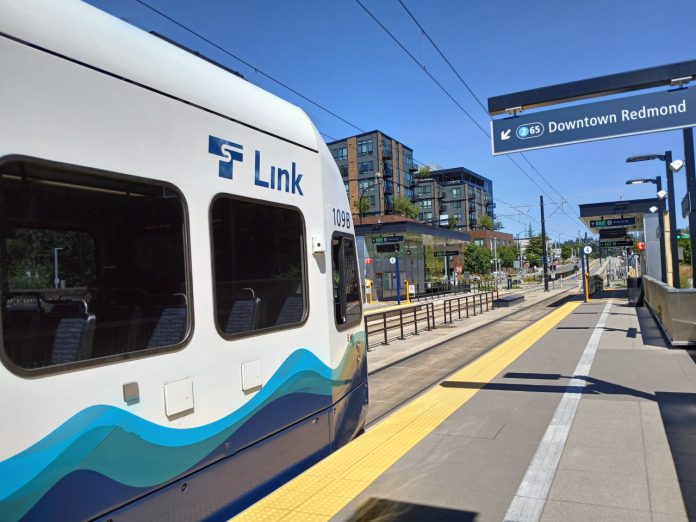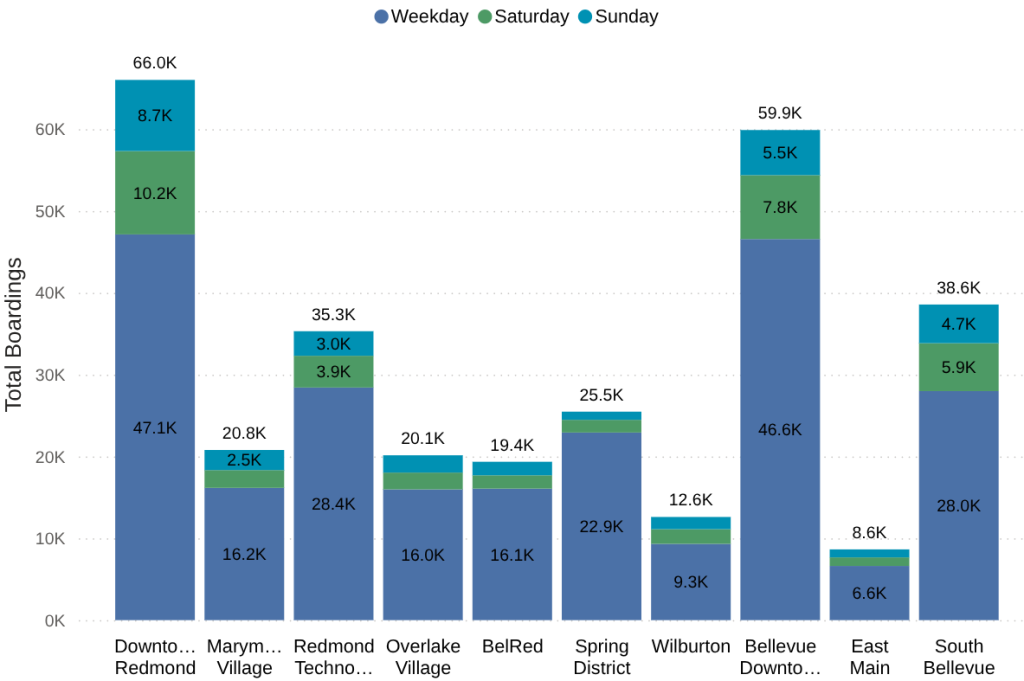
The good news around usage of Sound Transit’s 2 Line on the Eastside just keeps coming.
Last week, The Urbanist reported on data presented to the Sound Transit board’s rider experience committee showing how two new stations that opened in early May have been driving ridership increases on the entire line, with Downtown Redmond becoming the busiest rail station on the Eastside. Just days later, new numbers for July dropped — blowing the previous ridership records out of the water.
More than 306,000 riders boarded trains at 2 Line stations in July, a 47% jump in a single month and nearly 100,000 more riders than used the line in June. Average daily ridership on the full 2 Line climbed to over 10,700, dwarfing the modest expectations of 6,000 daily riders predicted last year when Sound Transit opened an abbreviated segment of the 2 Line, in the wake of continued delays to the I-90 cross-lake connection that will bring the line into Seattle.
The nearly 11,000 daily riders on the 2 Line means that its usage outpaced nearly every single King County Metro bus route, rivaling the powerhouse RapidRide E Line and Route 7. On July 23, when Sound Transit ran additional service later into the evening to accommodate a Brit Floyd concert at Marymoor Park, the line saw over 20,000 riders, a figure that has only been surpassed by the 2 Line’s two grand opening celebrations in 2024 and 2025.

Downtown Redmond remains the most popular station, with Downtown Bellevue close on its heels. South Bellevue and Redmond Technology Stations were a distant third and fourth. Wilburton and East Main, which have lagged behind other stations in Bellevue when it comes to nearby land use changes and development, have the lowest ridership. Bellevue has an impressive vision for Wilburton in particular, though those plans will likely take decades to come to fruition.

The entire 10 stations that make up the 2 Line might still be sitting empty and collecting dust if not for King County Councilmember Claudia Balducci and the work of advocates who pushed Sound Transit in late 2022 to activate the completed infrastructure on the Eastside as a separate “starter line.” That work has clearly paid dividends.
“Love these ridership numbers,” Balducci said in a Bluesky post in response to the latest ridership numbers. “This is why we fight to provide more and better transit. People want and need these services!”
This week Sound Transit board members also got more information than ever before about the source of the delays on the I-90 bridge. Sound Transit has nearly completed calibrating sensors for the cathodic protection system intended to protect the bridge from stray electrical current, according to a presentation on the agency’s capital work Thursday, and is hoping to receive the go-ahead from the Washington State Department of Transportation (WSDOT) after all of those systems are fully in place.
Earlier this week, CEO Dow Constantine portrayed an April 25, 2026 opening date listed in a recent status report as a safe bet that the agency could report to the Federal government. “I’m quite confident that we’re going to do a lot better than that,” Constantine told KUOW.
But it was clear in Thursday’s presentation that the schedule remains uncertain as long as the start of live wire testing continues to be pushed back.
“A month ago, we wanted to be into live wire testing, and so we are losing some time on that part of the project,” Michael Morgan, the Executive Director for the East Link delivery team, told the committee.
Live wire testing is expected to take 10 to 12 weeks, after which point Sound Transit can start running trains in pre-revenue service, which is planned to take around five to six months. But the schedule remains highly variable until Sound Transit gets the go-ahead to start testing on the bridge.
“There’s still a little bit of float in the schedule, but realistically, we need to get that first train going, and then very quickly after that, we’ll have a sense of how well the catenary testing is going, how well the signal testing is going, all of those things,” Morgan said. “So once we get into the actual movement of the trains, then we’ll be in a much better position to calibrate the schedule.”
When the 2 Line does finally connect into Seattle, ridership numbers will likely once again be blown out of the water. But for now, the 2 Line is clearly filling a mobility niche even without that connection.
Ryan Packer has been writing for The Urbanist since 2015, and currently reports full-time as Contributing Editor. Their beats are transportation, land use, public space, traffic safety, and obscure community meetings. Packer has also reported for other regional outlets including BikePortland, Seattle Met, and PubliCola. They live in the Capitol Hill neighborhood of Seattle.

